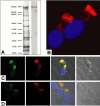Mislocalization of DNAH5 and DNAH9 in respiratory cells from patients with primary ciliary dyskinesia
- PMID: 15750039
- PMCID: PMC2718478
- DOI: 10.1164/rccm.200411-1583OC
Mislocalization of DNAH5 and DNAH9 in respiratory cells from patients with primary ciliary dyskinesia
Abstract
Rationale: Primary ciliary dyskinesia (PCD) is a genetically heterogeneous disorder characterized by recurrent infections of the airways and situs inversus in half of the affected offspring. The most frequent genetic defects comprise recessive mutations of DNAH5 and DNAI1, which encode outer dynein arm (ODA) components. Diagnosis of PCD usually relies on electron microscopy, which is technically demanding and sometimes difficult to interpret.
Methods: Using specific antibodies, we determined the subcellular localization of the ODA heavy chains DNAH5 and DNAH9 in human respiratory epithelial and sperm cells of patients with PCD and control subjects by high-resolution immunofluorescence imaging. We also assessed cilia and sperm tail function by high-speed video microscopy.
Results: In normal ciliated airway epithelium, DNAH5 and DNAH9 show a specific regional distribution along the ciliary axoneme, indicating the existence of at least two distinct ODA types. DNAH5 was completely or only distally absent from the respiratory ciliary axoneme in patients with PCD with DNAH5- (n = 3) or DNAI1- (n = 1) mutations, respectively, and instead accumulated at the microtubule-organizing centers. In contrast to respiratory cilia, sperm tails from a patient with DNAH5 mutations had normal ODA heavy chain distribution, suggesting different modes of ODA generation in these cell types. Blinded investigation of a large cohort of patients with PCD and control subjects identified DNAH5 mislocalization in all patients diagnosed with ODA defects by electron microscopy (n = 16). Cilia with complete axonemal DNAH5 deficiency were immotile, whereas cilia with distal DNAH5 deficiency showed residual motility.
Conclusions: Immunofluorescence staining can detect ODA defects, which will possibly aid PCD diagnosis.
Figures




References
-
- Ibanez-Tallon I, Heintz N, Omran H. To beat or not to beat: roles of cilia in development and disease. Hum Mol Genet 2003;12:27–35. - PubMed
-
- Afzelius BA, Mossberg B, Bergström SE. Immotile cilia syndrome (primary ciliary dyskinesis), including Kartagener syndrome. In: Scriver CS, Beaudet AL, Valle D, Sly WS, Childs B, Kinzler KW, Vogelstein B, editors. The metabolic and molecular bases of inherited disease, 8th ed. Vol. 3. New York: McGraw-Hill; 2001. pp. 4817–4827.
-
- El Zein L, Omran H, Bouvagnet P. Lateralization defects and ciliary dyskinesia: lessons from algae. Trends Genet 2003;19:162–167. - PubMed
-
- Holzbaur EL, Vallee RB. Dyneins: molecular structure and cellular function. Annu Rev Cell Biol 1994;10:339–372. - PubMed
-
- Witman GB, Wilkerson CG, King SM. The biochemistry, genetics and molecular biology of flagellar dynein. In Hyams JS, Lloyd CW, editors. Microtubules. New York: Wiley-Liss; 1994. pp. 229–249.
Publication types
MeSH terms
Substances
Grants and funding
LinkOut - more resources
Full Text Sources
Other Literature Sources
Medical
Molecular Biology Databases

